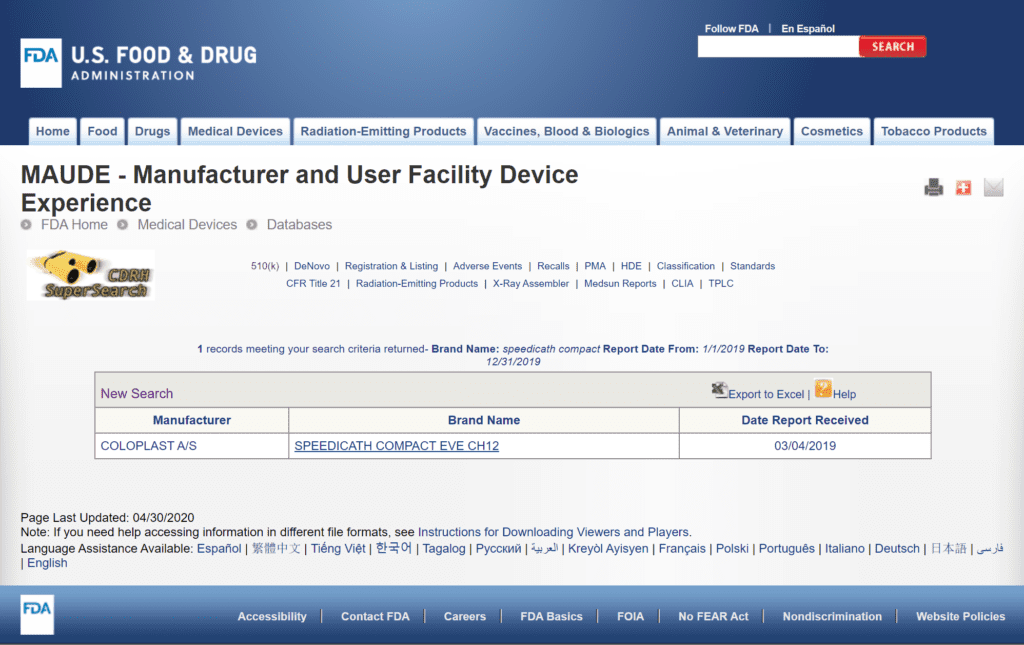Coloplast SpeediCath® Compact

Product Overview
Available Lengths: 2.75 inches (Female), 3.5 inches (Female – Compact Plus Variant)
Available French Sizes: 8, 10, 12, 14
Available Tips: Standard
Pros
Great packaging design, with an ingenious telescoping mechanism, gives this catheter a small, discreet footprint.
A stiff catheter means that mistakes during insertion are less likely.
Radiused and slightly inset catheter eyelets make urethral trauma less likely.
Our Verdict
This is a very solid, convenient, and compact choice for an intermittent catheter, especially if its short length and hydrophilic coating don’t cause any issues for you.
Cons
Inconsistent application of the hydrophilic coating leads to a rougher surface on the catheter than many other hydrophilic and ready-to-use catheters.
This catheter is shorter than most and won’t work for you if you have a longer urethra.
Material
The Speedicath® Compact is a compact format catheter that is made out of polyurethane, which is typical for the Speedicath® line, but sets it apart from many other catheters. Polyurethane is non-toxic and is a more expensive plastic than PVC, which is cheap but can negatively impact human health. Polyurethane can actually soften slightly at body temperature, potentially making it easier to insert once it’s inside the body. Polyurethane has good biocompatibility, and isn’t known to cause allergic reactions. It has unique chemistry owing to the fact that it is a segmented polymer that gives it both flexibility and strength.
The catheter is coated with a hydrophilic coating made out of polyvinyl pyrrolidone (PVP). More on PVP below in the lubrication section!
Flexibility

When held out by the funnel, the female version of this catheter droops down 0.25 inches while extending 3 inches, making it a pretty stiff catheter. This definitely helps in the insertion process, making accidental insertion into the vaginal canal less likely.
Packaging
This catheter’s packaging is pretty ingenious. The female version of the catheter clocks in at just 3.5 inches, making it the most compact catheter we’ve reviewed. The catheter’s design resembles a lipstick, and promotional images on the Coloplast® website show that this catheter is at home in an elegantly laid-out medicine cabinet or jewelry tray. Unfortunately, this design isn’t accessible and isn’t intended for individuals with limited dexterity.
To open the catheter, you grab either end of the cylindrical hard plastic casing, and twist. After breaking the seal, you pull apart the catheter. The cap of the catheter pulls the flexible catheter shaft out of the hard-plastic casing which snaps into place in its fully extended form. Just be careful not to pull too quickly, or you’ll get lubricant residue all over you. The casing features holes that allow urine to flow from the catheter and out the tail end of the catheter.
Like we said, pretty ingenious.
Lubrication
PVP is the hydrophilic coating that gives this catheter its lubricious quality. PVP is generally considered to be safe, but can cause allergic reactions in rare cases – so check with your physician if you’re unsure as to whether or not this catheter is right for you.
Uneven deposition of the hydrophilic coating on their surfaces seems to be a bit of a trend with Speedicath catheters. The surface of this Speedicath® variant was pretty rough, and we could feel distinct differences in different regions of the catheter.
Insertion
Video training materials for these catheters (and more!) made by Coloplast® can be accessed here.
The female version of this catheter is shorter than most – the flexible end of the catheter measures just 2.75 inches, making it one of the shortest catheters we’ve tested. The Compact Plus is 3.5 inches long if the 2.75 inch design won’t cut it. That’ll likely be enough for most people, but it’s important to know if you find that you end up inserting most traditional female catheters (which are usually 6 inches, with 5 inches of that being flexible) most of the way in to urinate.
This is a fairly stiff catheter, but doesn’t offer any protection from germs on the surface of the urethral opening. If you’re using this catheter and are worried about UTIs, remember to use antiseptic wipes to prepare the insertion area prior to catheterizing – and it couldn’t hurt to sterilize your hands either.

Like other Speedicath® catheters, this catheter features slightly inset, narrow eyelets. This is thought to reduce the chances of delicate tissue being caught in the eyelet during insertion. They aren’t quite as polished as the Cure Catheter®, but they are a step above the rest of the competition.
Adverse Events
There were no product complaints for the Speedicath® Compact registered with the FDA in 2019. (The complaint that you see in the following screenshot is for a different product.)

The review of FDA Medical Device Reports from 2019 provides a limited snapshot of recent product performance in the marketplace.